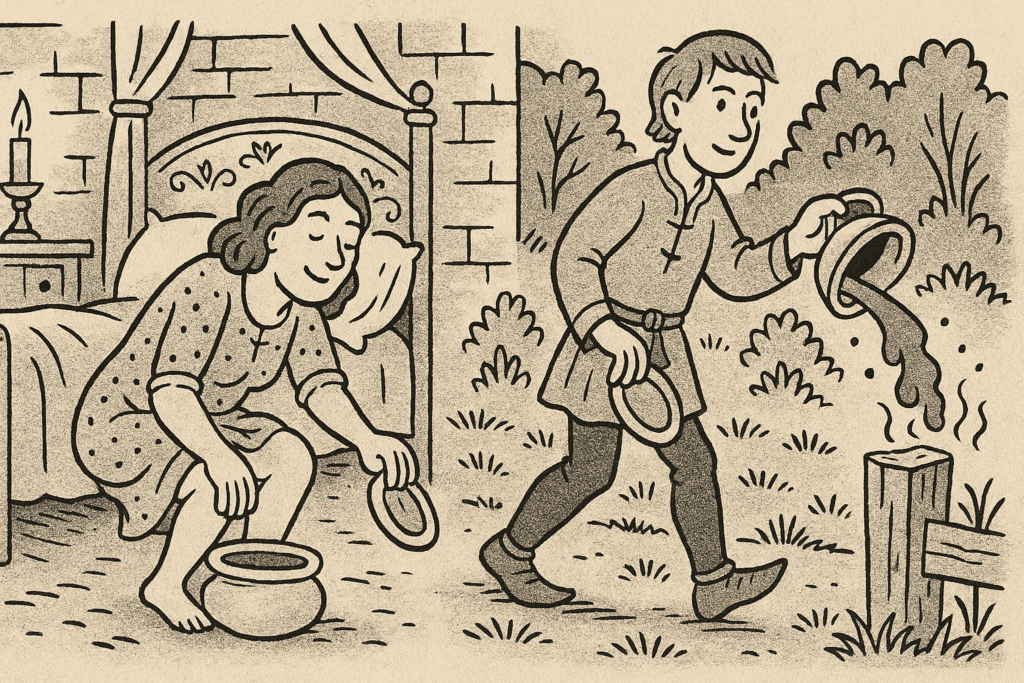Before plumbing, porcelain, or privacy, medieval people had to rely on forests, chamber pots, and drafty castle chutes. Toileting in the Middle Ages was not glamorous, but it was practical—and it shaped medieval life in surprising ways.
This post (and the linked Boring History for Sleep episode) explores how peasants, nobles, and townsfolk managed sanitation in medieval Europe, and what it reveals about daily life, hygiene, and social order.
Table of Contents
The Dirty Truth About Medieval Toilets
The Forest Edge: Nature’s Default Toilet
For peasants, going to the bathroom often meant going outside. There were no outhouses, no designated pits—just an understanding of where it was acceptable to squat.
People found a secluded spot near the edge of the woods or behind a hedgerow, well away from the well, the cottage, and the paths animals used. It was unscheduled, unmarked, and deeply familiar.
Hygiene was minimal, but the experience was shared. Everyone knew how to tuck their tunic, where to crouch, and which leaves worked best when the moment arrived. In summer, there were flies. In winter, there was wind. But always, there was the open air and a moment of quiet privacy.
TThe Castle Garderobe: Nobles and Drafty Privilege
Nobles had garderobes—small rooms projecting from castle walls with a wooden bench and a hole that emptied down a chute into the moat or open air.
- Pros: More private than the forest, protected from weather.
- Cons: Cold drafts, lingering smells, no real privacy.
Sometimes herbs were hung to mask odors. Wiping materials included moss, rags, or whatever was available.
Chamber Pots and Night Soil
In towns and at night, people used chamber pots—simple ceramic bowls kept under beds. Servants or children often carried them out in the morning to empty in gardens, rivers, or dumping sites.
The collected waste, known as night soil, was sometimes sold as fertilizer. It was smelly, routine, and entirely necessary.

Public Toilets: Rare but Real
Some cities had communal latrines, built over rivers or near guild halls. These were open stalls—simple wooden partitions with holes above running water. They offered a sense of community, or at least shared discomfort.
There were no locks, no flushing mechanisms, and rarely any kind of separation by gender. Just a platform, the occasional carved seat, and the gentle sound of water moving waste along.
Clothing and Toileting Logistics
Medieval clothing made toileting a challenge. Tunics, hose, and skirts had to be lifted and tied back.
- Men: Loosened braies and hose.
- Women: Gathered multiple skirts and underlayers.
- Everyone: Risked slips or accidents near garderobe openings.
Practicality often dictated fashion adjustments.
Smells, Shame, and Social Norms
Toileting was not considered shameful in the Middle Ages. It appeared in jokes, manuscript illustrations, and literature. But rank influenced where and how it happened:
- Nobles: Indoors, in garderobes.
- Peasants: Outdoors, near woods or fields.
- Servants/Children: Tasked with cleaning chamber pots.
Cleanliness was relative. Linen underclothes, herbs, and water helped, but smells were unavoidable.
Conclusion: The Eternal Routine
Toileting in the Middle Ages was neither glamorous nor hidden. It was practical, public, and full of texture—stone and wood, moss and water, wind and waste.
In castles and cottages, by rivers and hedges, people made do. They used what they had. They adapted their clothes, braved the smells, and carried on.
The next time you flush a toilet, think of the woman lifting three layers of wool in the forest. The servant with a sloshing pot at dawn. The wind howling up a stone shaft in a cold garderobe. For all our modern comforts, the routine remains the same.
Key Themes from the Narrative
- Peasant toileting in forests and hedgerows
- Castle garderobes and shaft-based waste disposal
- Chamber pots and night soil routines
- Rare communal latrines in medieval towns
- Clothing logistics and toileting
- Social structure and sanitation roles
- Smells, herbs, and public hygiene norms
